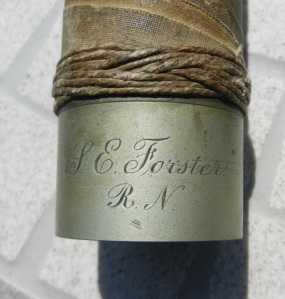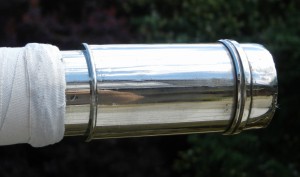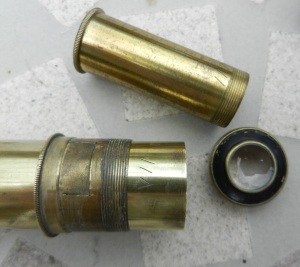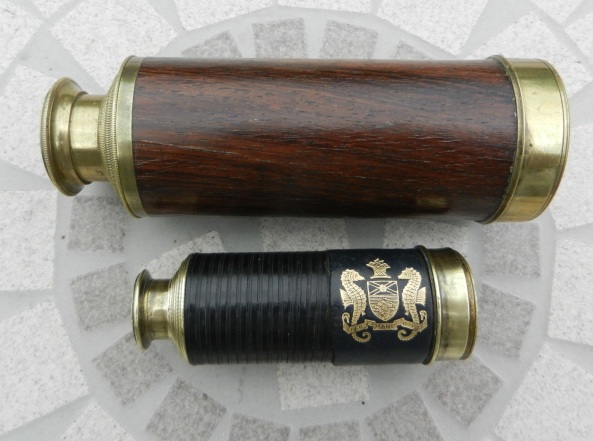This is a classic design “Officer of the Watch” telescope, but it has no maker’s mark. Having said that, after a good deep clean it turns out to be an expensively presented telescope, with good quality silver plating on all metal surfaces. The name of the owner is engraved on the bezel at the eyepiece end of the barrel, and it is S.E. Forster, RN. So this is the only clue to the history, except that the style of the scope and the engraving looks like late Nineteenth Century.
Captain Stewart Evelyn Forster
From data given on an Auction site relating to a sale in 2009 of Commander Forster’s medals:
Stewart Evelyn Forster was born in Wellington, New Zealand in December 1866, and entered the Royal Navy in the training ship Britannia in July 1881, aged 15 years. He was present as a Midshipman in HMS Temeraire at the bombardment of Alexandria on 11 July 1882, and was awarded the medal relating to the Egypt and Sudan campaign 1882-89. He enjoyed varied service and advancement in the period leading up the Great War: whether he had the telescope on board Temeraire is dubious – maybe he only acquired it after being promoted to a higher rôle than Midshipman, but whether he was still with the Temeraire is not known.
Separate research documentation shows that Commander Forster, when King’s Harbour Master at Dover in 1911, was one of the original 25 men who founded the Dover Aero Club, with club flying grounds established on Whitfield Hill, about three miles out of Dover. [My personal interest was triggered by learning that another founder member was Rev GH Andrews, Chaplain to the Duke of York’s Royal Military School: my father was an infant at that school, as an orphan of a soldier, from around 1913. But also this implies that this Forster telescope was one of the first telescopes liable to have been used for looking at aircraft, at the Aero Club grounds – which is what it is being used for now, in 2015, over Hampshire].
Forster was placed on the Retired List as a Captain in October 1913. Quickly recalled in August 1914, Forster was awarded his 1914 Star in respect of services as a Divisional Naval Transport Officer at Calais, in which post he remained employed until removing to the Immingham base Wallington in March 1917, services that resulted in the award of his Belgian Order of Leopold (London Gazette 22 June 1917 refers), in addition to a mention in despatches (London Gazette 4 January 1917 refers). His final wartime appointment, from June 1918, was as Deputy Superintendent and King’s Harbour Master at Pembroke. His medals were sold with a file of research, which I would love to consult!
HMS Temeraire
The HMS Temeraire that served off Alexandria in 1882 was not the ship painted by JMW Turner! That was the “Fighting Temeraire”, a 98 gun second-rate launched in 1798, which became a prison ship, and the picture showed her being towed from Sheerness to Rotherhithe – to be broken up – in 1838. This ‘Temeraire‘ played a distinguished role in Nelson’s victory at the Battle of Trafalgar in 1805, after which she became known as the ‘Fighting Temeraire’.
HMS Temeraire (1876) was an iron-hulled screw-propelled ship launched in 1876. She carried two ‘Disappearing guns’ on board, which fired over a metal parapet and then swung down below the parapet for re-loading. She became a training ship and was renamed Indus II in 1904, Akbar in 1915, and was sold in 1921.
There have been three ships of the same name over the years before 1798 and after 1904, and two shore establishments. The original Temeraire was captured from the French in 1759: the name means “Reckless”.
The telescope

 As bought on Ebay, the telescope had seen better days. Overall length, closed, is 17.25”, and open focused is 23”: the largest diameter is just over 1.5”.
As bought on Ebay, the telescope had seen better days. Overall length, closed, is 17.25”, and open focused is 23”: the largest diameter is just over 1.5”.
The metal parts looked very dull, on receipt, and the canvas covering seemed to have lost a layer of beading or similar around the edge of the canvas wrap.
.
.
.
.
.
After cleaning the metal came up as silver, with a real shine: there was a problem as to how to replace the canvas wrap economically, so it was covered with white material based tape. The result is reasonable, and maybe shows that the telescope looked “Top of the Range” when new. The tape used was adhesive backed, and very effective – see http://tinyurl.com/pqsloyk.
The only question remaining, having packed the moving joints with leather ‘sliders’ to tighten them up – similar to the felt padding seen in other telescopes of that era, is that the objective does not seem right. There is slight mould apparent between the objective pair, and it will not disassemble. This whole lens assembly does not screw in to the end of the barrel, and therefore the sunshade and objective can just be pulled off. There is either a retaining ring missing, or the objective assembly is a replacement unit, and too big in diameter to fit the original design. With no screw thread available or in evidence at the end of the barrel, something must have been an interference push-fit, to make the assembly secure. Currently the damage at the end of the sunshade retains the objective assembly in place.
Value?
Who knows. But I like it. It cost me £46 from a supplier in Kent, which is presumably where Forster and family settled after 1911 and after WW1, until his death in August 1937: he lived to the age of 70. It’s #240 in my collection, and I would suggest this is the oldest known telescope to almost certainly have been used to look at the oldest aircraft, flying. Anyone in 1911 setting up an aero club and owning a telescope like this would have used it to see what was happening around the airfield approaches. So it’s worth more to me than most other people!
Postscript: {Obviously I use my Eighteenth Century Dollond on modern, and some old, aircraft, but that’s not the same!}. Re-reading this story, I need to find the telescope from the “Fighting G”, with the G being for HMS Gloucester, who also earned the description “Fighting“, but more recently….
…..This telescope has a tenuous link with the Fighting Temeraire! a photo of JMW Turner’s picture is shown below.











